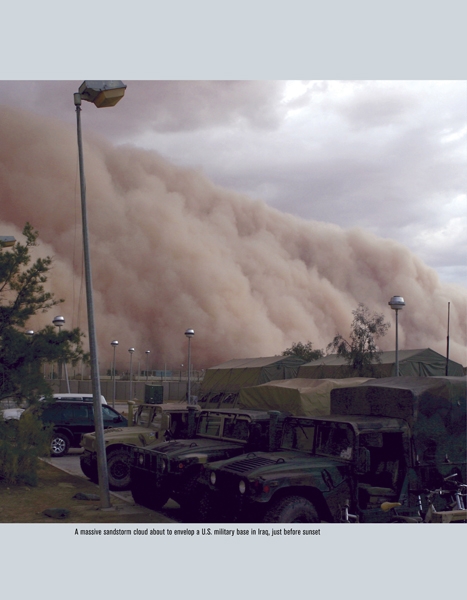

MOTHER OF ALL SANDSTORMS
"It was MOASS—the Mother of All Sand Storms! If you were a tank commander, you couldn't see your front slope. If you were a driver, you couldn't see your ground guide."
—GySgt Erik Benitez, USMC, battalion master gunner, 1st Tank Bn, I MEF
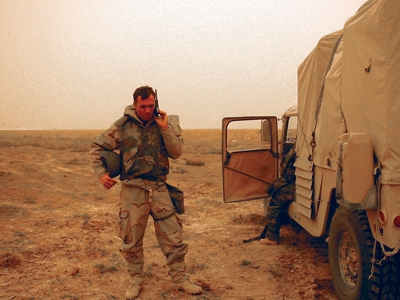
FOX's Greg Kelly talks via satellite phone as a sandstorm moves in
24–26 MARCH, NORTH OF NASIRIYAH
It began shortly after dark on Monday, 24 March, with a low-pitched moaning wind that lashed into the helicopter, whipping dirt around inside the bird. The temperature dropped as the wind rose. Though we were all wearing our chemical protective suits, we had to wrap up in poncho liners to stay warm enough to sleep.
Griff and I stayed with the air crews, shivering inside the helicopters, listening to the wind howl outside. Fine particles of grit swirled around inside the cabin, finding their way into every crevice—weapons, engines, instruments—even our broadcast gear.
By 0400, when we dragged ourselves outside to prepare for a "hit" on Hannity & Colmes, the satellite antenna we carried would have been blown away by the force of the wind had we not anchored it with a sandbag. The blowing sand had the appearance of fine driven snow through the green night lens of the camera.
These tiny airborne particles were a nuisance during our broadcast. But their effect on the pilots and drivers was far more profound. Even on the hard surface roadway, the never-ceasing stream of armored vehicles, trucks, and tanks moving north slowed to a crawl because the drivers couldn't see the vehicle in front of them. And the helicopter air crews didn't relish the idea of flying in weather like this. Nobody wants the stress of flying blind at fifty feet above the ground.
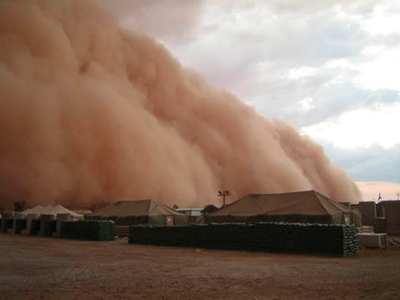
Iraqi sandstorms can take on biblical proportions . . .
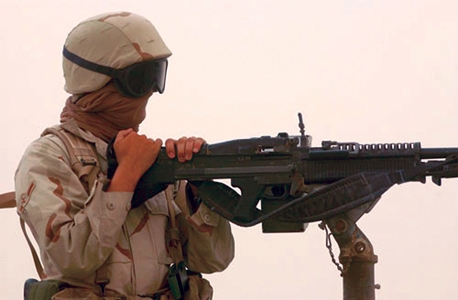
. . . and reduce visibililty to zero in only minutes . . .
Dawn came late—made so by the unearthly haze of wind-whipped sand. When the sun did rise, only the colors shifted. The powdery "moon dust" turned everything—earth, sky, vehicles, even the haze-gray helicopters—the color of rust. It lined our nostrils, caked on our skin, and stung the eyes. But these were mere distractions compared to the real danger posed by the fact that the Marines couldn't see the enemy—or anything else beyond a few meters.
But on the plus side, everything moved slower inside the storm, so many Marines took advantage of the lull to catch up on sleep and fine-tune their planning inside the command post. Someone handed me a cup of hot coffee, and I listened in as two CIA paramilitary officers debated about whether the storm could be properly described as a sharqi or a shamal. They finally asked two Kuwaiti officers accompanying RCT-5 as interpreters. Unfortunately, the Kuwaitis couldn't resolve the issue either, prompting one of the Americans to observe with a shrug, "It's been that way over here for thousands of years—the people in this part of the world can't even agree about the weather. Let's just say that this is a sandstorm of biblical proportions." They got no disagreement from me.
The command post for RCT-5 had once been a school, then later an arsenal for Saddam's Baath Party. I trudged up the stairs of the one-story building to get a look around, but the blowing sand made the effort futile. On the roof, four Marines were pulling security, one on each corner. In addition to their helmets, body armor, and chemical suits and dust goggles, their faces were wrapped Bedouin-style with the dark green slings from their first-aid kits. The frigid wind was downright fierce. I asked the fire team leader, a corporal, if they'd seen anything.
The look I got from the Marine NCO had "stupid question" written all over it. "The entire Iraqi army could be out there, and we wouldn't know it until they were knocking on the front door."
Fortunately, though the troops on the ground couldn't see any farther than we could spit, they had friends in high places with a much better view. Well above the storm, JSTARS aircraft were still identifying targets and passing them along to the artillery, as evidenced by the "crump, crump, crump" of the 11th Marines' 155-mm howitzers firing over our heads.
The Iraqi artillery was firing too. Emboldened by the concealment offered by the blowing sand, they started hammering our front lines with mortar and rocket fire. American counter-battery radar could still see in the gloom. So even before the enemy rounds landed, entire battalions of American artillery zeroed in on the enemy positions and returned the fire.
The sandstorm grounded the Marines' close air support (CAS) fixed-wing aircraft—the F-18s and AV-8 Harriers. This became immediately obvious to the Iraqis who took the opportunity to try to move troops and equipment under cover of the dust. What they didn't know was that the sensors and automated target-plotting systems aboard U-2, JSTARS, and EP-3 aircraft flying above the red clouds were still able to track them and send GPS-guided munitions in for the kill. Within minutes of detecting an Iraqi convoy or radio emission, one or more of a wide variety of missiles, rockets, or artillery would come streaking out of the sky to ruin the enemy's day.
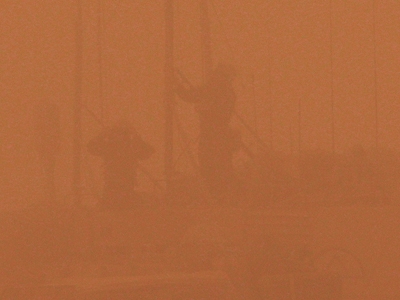
. . . shutting down nearly all operations until they pass
While standing on the roof of the school-turned-Baath-ordnance-depot-turned-U.S.-Marine-command-post, we could hear some of these high-altitude aircraft, and a moment later we felt a large explosion off to the north. Some unsuspecting Iraqi who thought he couldn't be seen had just learned otherwise—prompting a predictable response from the Marines: "Yeah, man! Get some!"
Griff Jenkins appeared out of the orange mist a few moments later and shouted over the wind, "We have a cas-evac. Let's go." As I hustled down stairs for the mission brief, I wondered if the blast we heard might have caused "friendly" casualties. Inside, I learned from Lt. Col. Jerry Driscoll that this wasn't the case.
Two RCT-5 Marines had been seriously wounded by an RPG during a skirmish with an Iraqi infantry patrol. I watched Driscoll and his wingman, Capt. Aaron "Fester" Eckerberg, plot the grid of the pickup zone and the en route checkpoints on their charts. They jotted down the frequency of the unit waiting for them on the ground, then we all hurried outside to the helicopters. The weather was still deteriorating, but neither pilot showed any sign of hesitation. No questions. No complaints. They were going to get one of their own and bring him to safety.
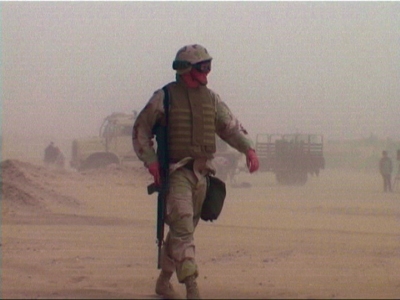
We stumbled through the gathering gloom to the aircraft where we were joined by two Navy shock-trauma medical corpsmen. As we lifted off, I heard Gunny Pennington, the crew chief, say over the intercom, "Nice day for flying, eh, Colonel?"
Driscoll's deadpan voice came back, "Ah yes. Red Dragons . . . real players." I stuck my head out the right side hatch with my camera, noticing that Capt. Eckerberg's CH-46, though only seventy-five feet away, was nearly invisible in the dusty haze. The ground was indiscernible as well, about the same distance below. Driscoll's instruments showed we were doing less than half our normal speed of 120 knots, which is good since there was no horizon and everyone aboard was straining their eyes for power lines, radio towers, light poles, and highway overpasses—hoping to see them before we hit them. By the time we got near our objective, forty minutes had passed.
The rifle platoon commander who had called for the cas-evac does a good job directing us to his location, about 1,500 meters east of the highway. Though we can't see him and he can't see us in the soup, he succeeds in bringing us in by the sound of our rotors.
For a few moments, the sandstorm works to our advantage. We have flown past the Marine position. Over the radio, the platoon commander tells us to turn back to the south. But in so doing we fly directly over the enemy force that attacked his platoon an hour ago. As we make our approach, I hear the distinctive "crack" of AK-47s firing in our direction. But the Iraqis or fedayeen can't see us and are firing wildly. I thank God once again that these guys don't know how to shoot.
Driscoll finds the zone and we land to find that one of the two casualties—the platoon's Navy medical corpsman, hit by the full force of an RPG—has died without regaining consciousness. The Marines who race aboard our CH-46 gently lower the litter holding his body to the floor of the helicopter and run back out again. There is no time for sadness, but the other corpsmen in the aircraft are clearly affected by the loss of one of their own.
The other casualty, a Marine corporal, has multiple fragment wounds—one of which is a life-threatening piece of shrapnel in his abdomen from an RPG. Driscoll orders the wounded corporal to be loaded aboard Eckerberg's aircraft, and we launch immediately for the Army shock-trauma hospital some fifty miles to our southeast.
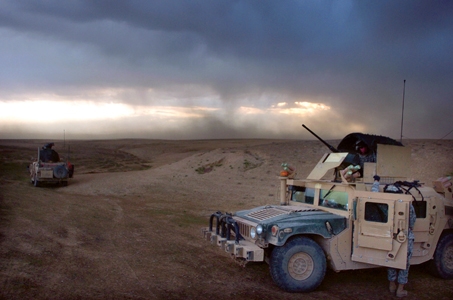
Dust is a constant enemy, causing problems with electronics, weapons, and vehicles
But now the full effects of this sharqi or shamal—or whatever the sandstorm was called—descended upon us. Unable to see the ground from fifty feet, Driscoll brought us down to twenty-five feet and reduced air speed to less than thirty knots. We virtually air-taxied back down Route 1—the wheels just off the ground, the rotor tips barely visible in front of us. Col. Driscoll's voice came over the intercom, as calm as if he were out for a Sunday afternoon drive, "Gunny, keep a sharp eye out. I sure don't want to bump into someone coming this way in our lane."
We crept along this way for half an hour. The conditions were a pilot's nightmare. We edged up to overpasses, skirted power lines, and prayed for protection. Before long, Capt. Eckerberg radioed that his bird was having engine problems. Driscoll told him to set it down on the roadway. We followed suit, waiting with engines running in the gloom.
Thirty minutes passed before Eckerberg's crew was able to patch things up so we could continue our harrowing low-speed, low-altitude, low-visibility flight. But after another half hour or so of skimming along a few feet above the road, Eckerberg reported that he was about to lose his left engine. We landed on the roadway once again, this time shutting down to avoid sucking any more sand into the engine.
On Driscoll's orders, Gunny Pennington went out to look for the other helicopter. I tagged along, figuring Eckerberg and crew were, at most, a couple of hundred yards behind us. For security, we each grabbed an M-16 and some ammo magazines. I took my GPS and Camelback water bladder, and then we headed back down the highway.
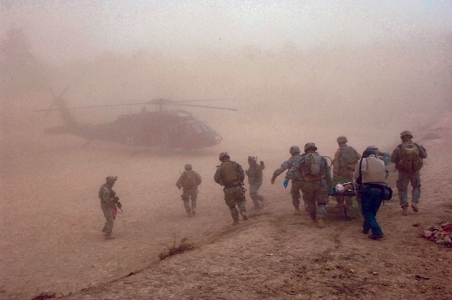
U.S. Army soldiers from the 82nd Airborne Division evacuate wounded soldiers during a sandstorm
But the other chopper wasn't there. We kept walking and calling on the radio, but the static-charged dust swirling about rendered it useless. Even my GPS signal was intermittent. When we'd traveled over a mile back down the highway and found nothing, we decided it wouldn't do for us to end up as captives being paraded before the Al Jazeera and Iraqi state-run television cameras. We turned around and hurried back the way we'd come.
Aboard Griff's bird, two Navy shock-trauma medical corpsmen, Chief Tom Barry and PO Jason Comeaux, had started treating the wounded Marine corporal as soon as he was brought aboard. There was little they could do to treat the shrapnel wound in his gut. The docs feared he was in danger of internal bleeding and going into shock, so they started an IV and wrapped him in blankets.
Medical corpsmen are tough, brave, yet amazingly gentle men. Chief Barry had seen combat before. When our aircraft were forced to land, he announced, "We've only got hours here; we don't have days to get someone with a gut wound into surgery."
We've been here for hours, huddled in the belly of the darkened aircraft, alone in the center of the deserted highway. Over the noise of the wind we can hear the sound of gunfire and mortar or RPG impacts about a kilometer off to our north. From the volume of fire it sounds like a really intense engagement, and it seems to be getting closer. To make matters worse, we have no idea where the nearest "friendlies" are. For all we know, the next thing we might see is a group of Iraqis or fedayeen on "technicals"—those pick-up trucks with a .50-cal mounted on the back—roaring down the road behind us. Magazines and ammo have been distributed to all, and we are prepared for the worst.
Inside the chase bird, Chief Barry and "Doc" Comeaux had Griff playing the role of "nurse" for the badly wounded corporal. While one of the "docs" stood guard, he helped the other corpsman change the blood-soaked battle dressings, switch IV bags, and pat his lips with a moistened gauze pad to relieve his thirst.
By dark, the young Marine's temperature was rising, his pulse and blood pressure were growing steadily weaker, and there was blood in his urine. Chief Barry sat up with him for the entire night in the shuddering CH-46 as the wind howled outside.
Just after dawn on Tuesday, 25 March, a Marine Humvee with a big American flag fastened to its side came creeping down the road. We were fortunate that it wasn't an Iraqi or fedayeen vehicle because we couldn't hear or see it until it almost hit the back of the helicopter. The driver, a Marine lieutenant colonel named Stroehman, was out reconnoitering a location for a FARP just south of our position when the sandstorm hit. He and his men had spent the miserable night in the open along Route 1.
It was Stroehman who came up with an ingenious solution for getting the disabled helicopter to a safer location. Using a strap from a large cargo net and his Humvee, he towed the CH-46 to his defensive perimeter like an oversized camping trailer. Once that was done, they considered loading the wounded man on Stroehman's Humvee and trying to crawl down Route 1 to the field hospital at Tallil. But they decided against it since they didn't know if enemy units were between them and the FARP, and darkness was already settling in again.
Through the second night, the wounded Marine suffered terribly. Dust caked around his nostrils, mouth, and eyes. The doctors administered small amounts of morphine to ease his pain and antibiotics through the IVs in hopes of reducing the infection from his stomach wounds. Each time the wind buffeted the CH-46 he gritted his teeth as he, along with the rest of us, was pummeled like a load of laundry in an unbalanced washing machine.
On the morning of the 26th the wind changed to a strong but steady breeze. We could finally see the glow of the sun—still overcast, but the storm was obviously blowing itself out. As the ceiling lifted and the visibility improved slightly, a Marine Corps Huey helicopter came hovering slowly down the road, looking for fuel. Lt. Col. Stroehman directed the bird to land next to one of his fuel trucks and told the pilot, Maj. Tim Kolb, about the plight of the wounded corporal. Maj. Kolb agreed instantly to take him to the hospital at the Tallil FARP.
Finally, as the weather cleared at dawn on the 27th, we were able to evacuate the body of our deceased Navy corpsman, HM3 Michael Johnson. A CH-46 from HMM-268 took his remains back to Kuwait. His family in Little Rock, Arkansas, was informed of their terrible loss. A year later a new medical clinic at the Marine Corps recruit depot in San Diego was named in his honor—a reminder to all new recruits that Marines love their corpsmen.
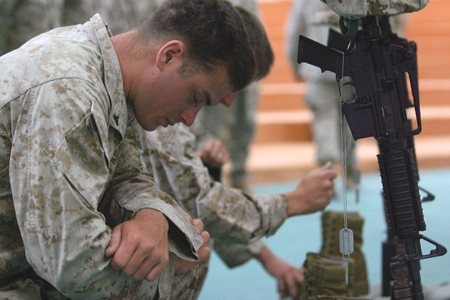
U.S. Marines pay their final respects during a memorial service for three fallen comrades